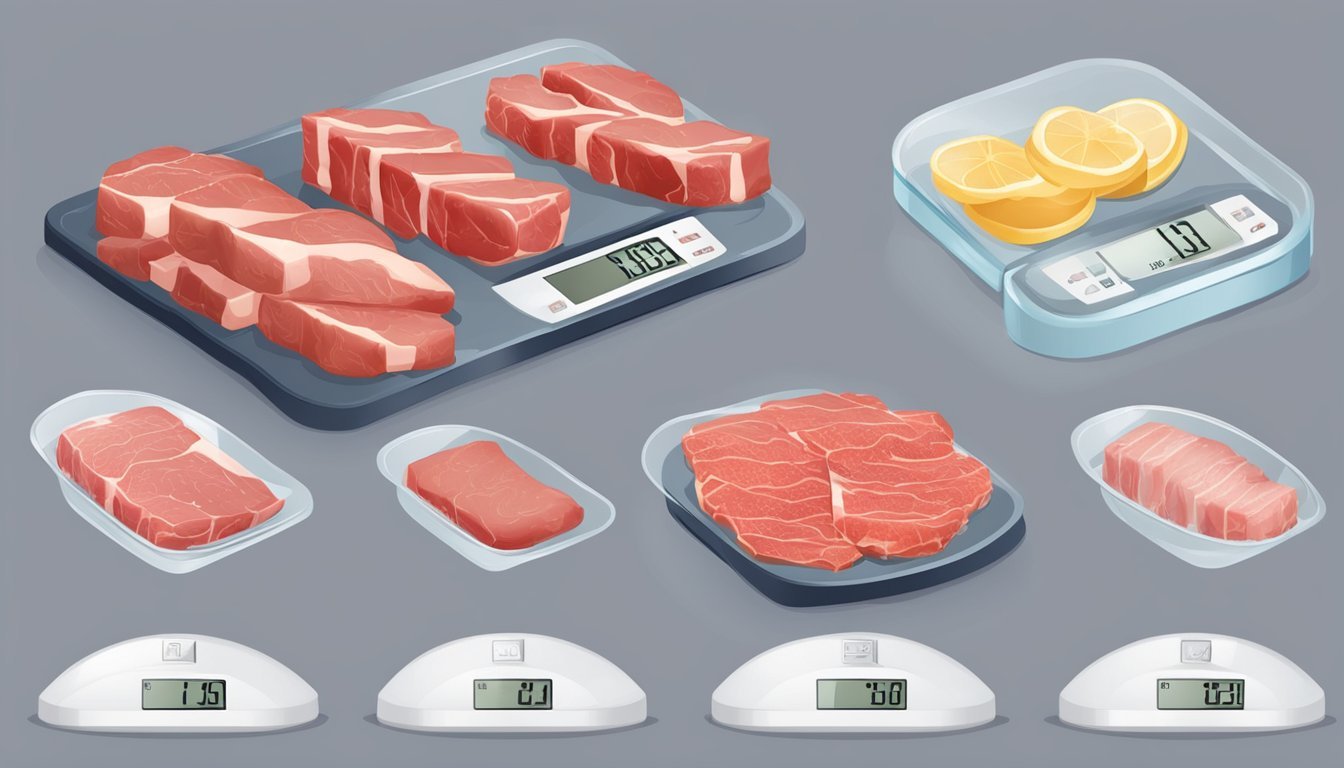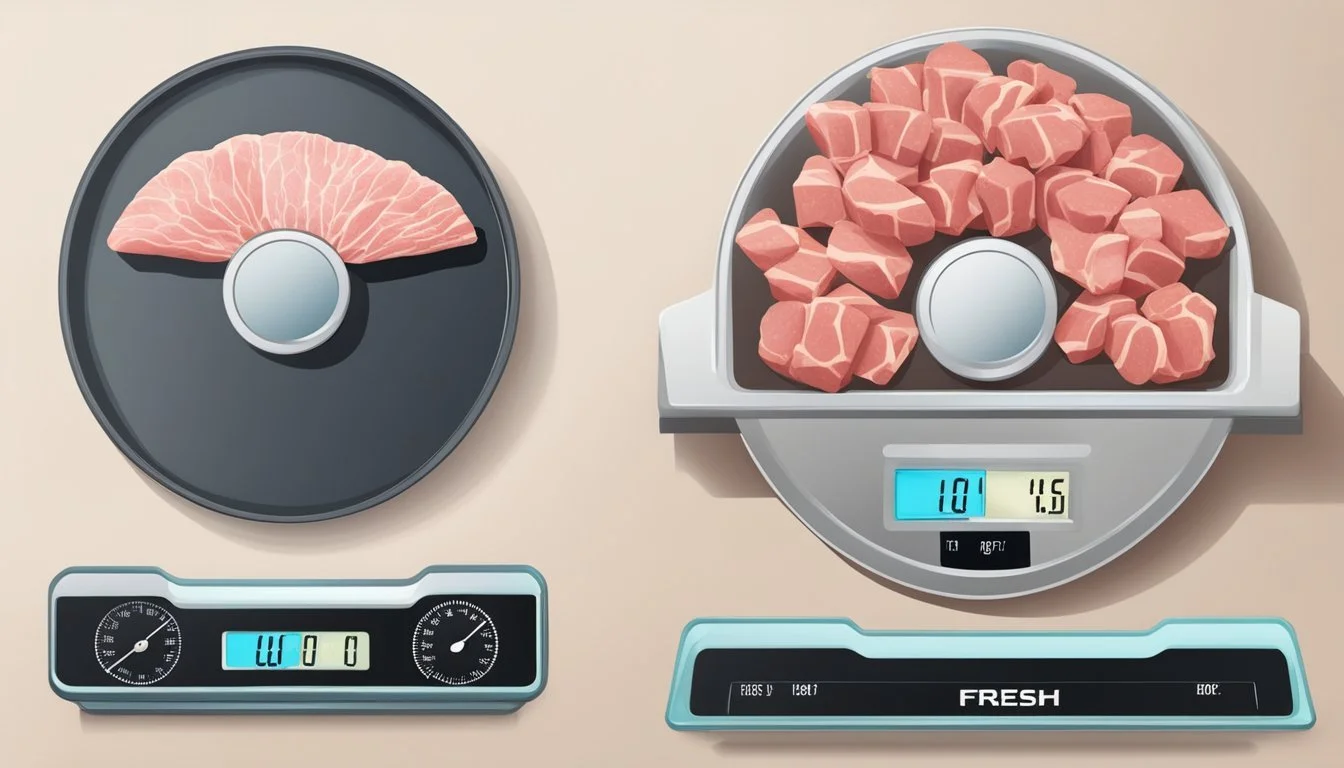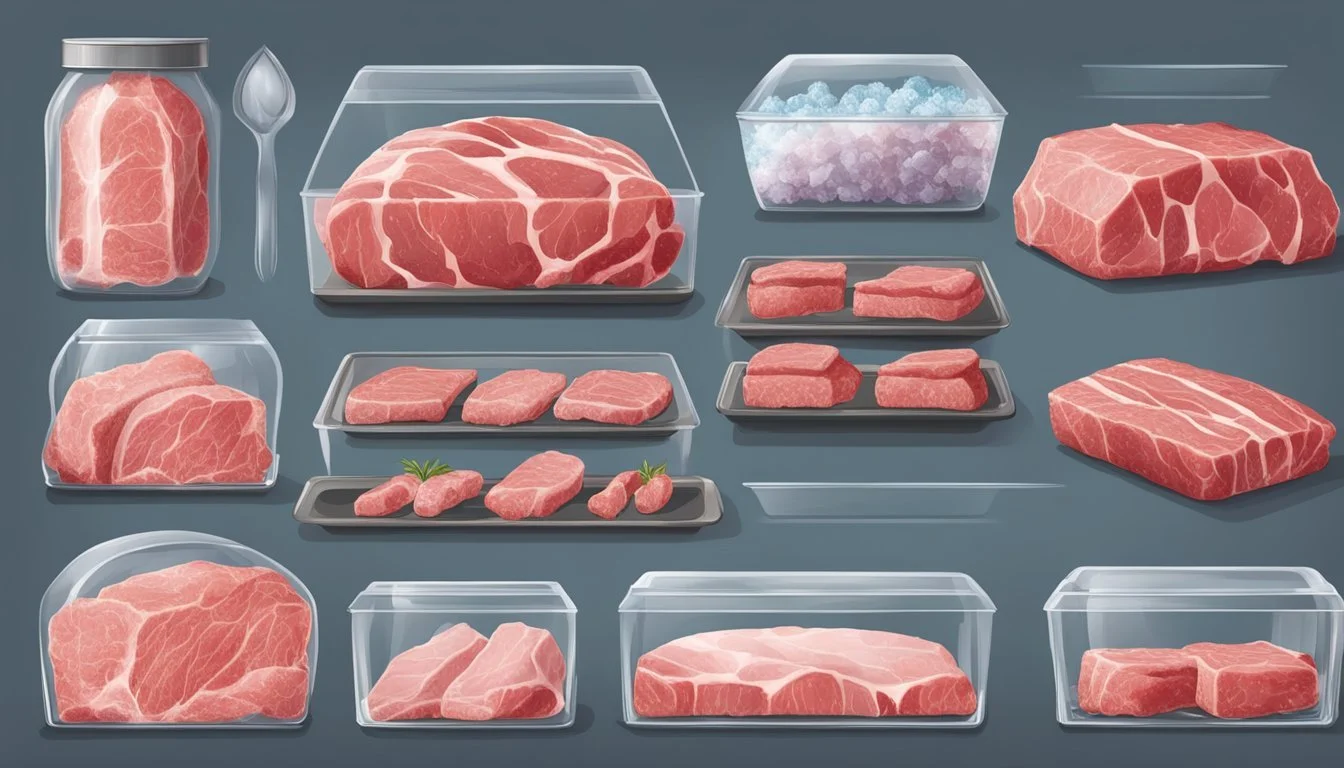Frozen vs Fresh Meat Weight: Thawing the Truth
The age-old debate between frozen and fresh meat extends beyond taste and convenience to include questions about weight differences. Many consumers wonder if freezing affects the overall mass of their meat purchases.
In general, frozen meat weighs approximately the same as fresh meat, with only minimal differences. The freezing process may cause slight changes in water content, but these variations are typically negligible for most practical purposes.
Factors like the specific type of meat, freezing method, and thawing technique can influence any minor weight discrepancies. Understanding these nuances can help shoppers make informed decisions when choosing between fresh and frozen options at the grocery store.
Understanding Meat and Freezing Basics
Meat undergoes significant changes during the freezing process, affecting its weight, texture, and quality. These changes stem from the transformation of water within the meat into ice crystals.
Defining Fresh and Frozen Meat
Fresh meat refers to meat that has not been frozen and is typically stored at refrigeration temperatures. It retains its original moisture content and cellular structure. Fresh meat often has a brighter color and firmer texture compared to its frozen counterpart.
Frozen meat has been subjected to temperatures well below freezing, usually around -18°C (0°F) or lower. This process halts bacterial growth and slows enzymatic reactions, extending the meat's shelf life. Frozen meat can be stored for months without significant quality loss.
The Science of Freezing Meat
When meat freezes, the water within its cells forms ice crystals. This process can cause slight changes in the meat's structure and weight. As water expands when frozen, it can rupture cell membranes, potentially affecting texture upon thawing.
The freezing rate impacts ice crystal formation. Rapid freezing creates smaller crystals, minimizing cellular damage. Slow freezing leads to larger crystals, which can disrupt the meat's structure more significantly.
During thawing, some moisture loss occurs as ice crystals melt. This process, known as drip loss, can result in a slight weight reduction compared to the meat's fresh state. The extent of this loss varies depending on factors such as meat type, cut, and freezing method.
Weight Considerations for Meat
Frozen and fresh meat differ in weight due to moisture content changes. Understanding these variations is crucial for accurate cooking and portioning.
Effect of Freezing on Weight
Freezing meat impacts its weight. Ice crystals form within the meat's cells during freezing, causing some moisture loss. This process can lead to a slight decrease in weight compared to fresh meat.
The duration of freezing also affects weight. Longer freezing periods may result in more moisture loss. High-quality meat with lower water content tends to lose less moisture during freezing.
Packaging methods influence weight retention. Vacuum-sealed meats typically maintain more moisture than those stored in standard freezer bags.
Measuring Frozen vs. Thawed Weight
Weighing frozen and thawed meat yields different results. Frozen meat often weighs slightly more due to ice formation. Thawing causes moisture loss, reducing the meat's weight.
Thawing methods affect final weight. Slow thawing in the refrigerator preserves more moisture than rapid thawing techniques like microwaving.
For accurate measurements, weigh meat before freezing and after thawing. This practice helps account for moisture loss during the freezing and thawing process.
When following recipes, consider potential weight changes. Adjust ingredient quantities if necessary to maintain proper ratios in dishes.
Nutritional and Quality Aspects
Freezing meat impacts its nutritional value and quality characteristics. These effects are important to consider when choosing between fresh and frozen options.
Nutritional Value Preservation
Freezing generally preserves the nutritional content of meat well. Protein levels remain stable during freezing and storage. Most vitamins and minerals are retained, with minimal losses. B vitamins like thiamin may decrease slightly but remain at nutritionally significant levels. Fat-soluble vitamins A, D, E, and K are largely unaffected by freezing.
Frozen meat can maintain its nutrient profile for many months when stored properly. Vacuum-sealed packaging helps prevent freezer burn and nutrient degradation. Rapid freezing forms smaller ice crystals, better preserving cellular structures and nutrients.
Quality Differences Impact
Fresh meat typically has a firmer texture and brighter color than thawed frozen meat. Ice crystal formation during freezing can damage muscle fibers, leading to a softer texture and increased moisture loss when thawed. This can affect juiciness and mouthfeel.
Flavor differences may be noticeable, with fresh meat often having a more pronounced taste. However, proper freezing and packaging techniques minimize flavor changes. High-quality meat with lower water content tends to maintain its quality better when frozen.
Appearance changes like freezer burn can occur in improperly stored frozen meat, affecting visual appeal. Fresh meat may have a shorter shelf life but allows for immediate use without thawing time.
Textural and Flavorful Characteristics
Freezing meat impacts its texture and flavor in distinct ways. The formation of ice crystals and changes to moisture content during freezing and thawing processes alter the meat's cellular structure and taste profile.
Texture Changes Post Freezing
Frozen meat undergoes significant textural changes. Ice crystals form within the meat's cells during freezing, potentially rupturing cell walls. This cellular damage can lead to a less firm texture upon thawing.
The meat may become slightly spongier or softer compared to its fresh counterpart. Rapid freezing methods can minimize this effect by creating smaller ice crystals.
Thawing also plays a role in texture. Slow thawing in the refrigerator helps retain moisture better than rapid thawing methods, preserving texture quality.
Flavor Retention and Enhancement
Freezing can impact the flavor of meat, though the extent varies. Properly frozen and stored meat generally retains most of its original taste. However, prolonged freezer storage may lead to subtle flavor changes.
Some cuts may develop a slightly metallic or "freezer burn" taste if not properly wrapped or stored too long. Vacuum-sealing can help preserve flavor by reducing air exposure.
Interestingly, some chefs argue that certain meats, like beef, can benefit from brief freezing. This process may enhance tenderness and concentrate flavors by breaking down muscle fibers.
Seasoning meat before freezing can help lock in flavors, potentially enhancing taste upon thawing and cooking.
Food Safety and Storage
Proper storage and handling of frozen and fresh meat is crucial for maintaining quality and preventing foodborne illness. Following recommended practices helps maximize shelf life and ensure food safety.
Avoiding Freezer Burn and Spoilage
Freezer burn occurs when air reaches the meat's surface, causing dehydration and oxidation. To prevent this, use airtight packaging or vacuum sealers. Double-wrap meats in plastic wrap or freezer paper, then place in freezer bags with air removed.
Store meats at 0°F (-18°C) or below. Use a freezer thermometer to verify temperature. Place newer items towards the back and older items in front for proper rotation.
Label packages with contents and date. Most meats can be frozen 3-12 months. Ground meats have shorter freezer life than whole cuts.
Keep raw meats on the bottom shelf of the freezer to prevent cross-contamination from drips.
Safe Defrosting Procedures
Never thaw meat on the counter at room temperature. This allows bacteria to multiply rapidly. Instead, use one of these safe methods:
Refrigerator: Place meat on a plate on the bottom shelf. Allow 24 hours per 5 pounds.
Cold water: Submerge in cold water, changing every 30 minutes. Cook immediately after thawing.
Microwave: Use defrost setting. Cook immediately after thawing.
Once thawed, refrigerate and use within 1-2 days. Never refreeze raw meat that has been thawed.
Cook thawed meats to safe internal temperatures to kill any bacteria. Use a food thermometer to verify doneness.
Cooking Techniques and Considerations
Cooking frozen meat requires adjustments to ensure optimal results. Proper techniques can help maintain quality and flavor while addressing safety concerns.
Adapting Cooking Times and Methods
Frozen meat typically requires 50% longer cooking time compared to fresh meat. Use a meat thermometer to verify internal temperatures reach safe levels. For roasts, lower the oven temperature by 25°F and increase cooking time by 1.5 times.
Slow cooking methods work well for frozen meats. Crockpots and pressure cookers can safely handle frozen cuts, though initial cooking times may need extension. Avoid high-heat methods like grilling or pan-searing for large frozen pieces, as they can lead to uneven cooking.
Thinner cuts like steaks or chops can be cooked from frozen using the reverse sear method. Start in a low oven, then finish with a quick sear for browning.
Utilizing Frozen Meat Efficiently
Plan meals around frozen meat to reduce waste and save time. Partially thaw larger cuts for easier slicing before refreezing unused portions. This technique allows for portioning without complete defrosting.
Marinate frozen meat as it thaws for enhanced flavor. Place frozen meat in a sealed bag with marinade and refrigerate overnight. The meat will absorb flavors as it defrosts.
Cook frozen ground meat directly in sauces or stews. Break the meat into chunks as it cooks, stirring frequently to ensure even heating. This method works well for dishes like chili or meat sauce.
Variations Among Different Types of Meats
Meat varieties respond differently to freezing and thawing processes. These variations impact weight, texture, and overall quality when comparing fresh and frozen options.
Handling Red Meat vs. Poultry
Red meats like beef and pork tend to retain more moisture during freezing than poultry. This results in less weight loss for frozen red meat cuts compared to chicken or turkey. Beef typically loses 1-2% of its weight when frozen, while chicken may lose up to 4%.
Frozen chicken breasts often have a higher water content than their fresh counterparts due to processing methods. This can lead to weight differences when thawed. Raw poultry is more susceptible to freezer burn, affecting texture and taste.
Defrosted red meat may appear slightly darker than fresh cuts. This color change doesn't indicate spoilage but is a normal reaction to the freezing process.
Seafood Specifics: Freshness vs. Frozen
Fresh fish degrades quickly, losing moisture and flavor within days. Properly frozen fish can maintain quality for months. Frozen fish fillets may weigh slightly less than fresh due to ice crystal formation during freezing.
Frozen shrimp often retain more moisture than fresh, potentially weighing more when thawed. This extra water can affect cooking times and final texture.
Cooked seafood loses more moisture during freezing than raw varieties. This can result in a noticeable weight difference and potential texture changes when reheated.
Flash-frozen fish at sea can sometimes surpass the quality of "fresh" fish that's been transported for days. This method preserves texture and nutritional value effectively.
Environmental and Economic Impact
Freezing meat impacts food waste, energy use, and consumer costs. Proper storage and handling of frozen meats can provide both environmental and financial benefits.
Reducing Food Waste with Frozen Options
Freezing meat extends its shelf life significantly, helping to reduce food waste. Fresh meat typically lasts only a few days in the refrigerator, while properly frozen meat can be safely stored for months. This longevity allows consumers to buy in bulk and store excess meat for later use.
Frozen meat also enables more efficient use of animal products. Processors can freeze less popular cuts or excess inventory instead of discarding them. This practice maximizes the use of each animal and reduces waste throughout the supply chain.
However, freezing requires energy for storage and transportation. Modern freezing technologies and energy-efficient appliances help mitigate this impact.
Economic Considerations for Consumers
Frozen meat often costs less than fresh options, allowing consumers to save money on protein sources. Buying in bulk and freezing can lead to significant savings over time.
Frozen meats are less prone to spoilage, reducing the likelihood of wasted money due to discarded food. This benefit is especially valuable for households with unpredictable meal schedules or consumption patterns.
However, consumers must consider the energy costs of long-term freezer storage. Efficient freezers and proper organization can help minimize these expenses.
Frozen meats also provide price stability, as consumers can stock up during sales and promotions. This strategy allows for more consistent budgeting and protection against short-term price fluctuations in the meat market.
Guidance for Consumers
Selecting and managing meat products requires careful consideration. Proper handling and storage practices ensure safety and maximize quality for both fresh and frozen options.
Choosing Between Fresh and Frozen Meat
Compare prices and expiration dates when deciding between fresh and frozen meat. Fresh meat often costs more but offers immediate use. Frozen meat provides longer storage and potential cost savings.
Check packaging integrity for both types. Fresh meat should have no discoloration or strong odors. Frozen meat packages should be free of frost or ice crystals, indicating proper storage.
Consider your meal planning needs. Fresh meat is ideal for immediate consumption. Frozen meat offers flexibility for future use.
Best Practices for Meat Management
Store fresh meat in the coldest part of the refrigerator, typically the bottom shelf. Use within 1-2 days for ground meat and 3-5 days for whole cuts.
Keep frozen meat at 0°F (-18°C) or below. Use within 3-4 months for ground meat and 4-12 months for whole cuts, depending on the type.
Thaw frozen meat safely in the refrigerator, cold water, or microwave. Never thaw at room temperature.
Use airtight containers or freezer bags to prevent freezer burn when storing meat long-term.
Label packages with the date of purchase or freezing to track storage time.









